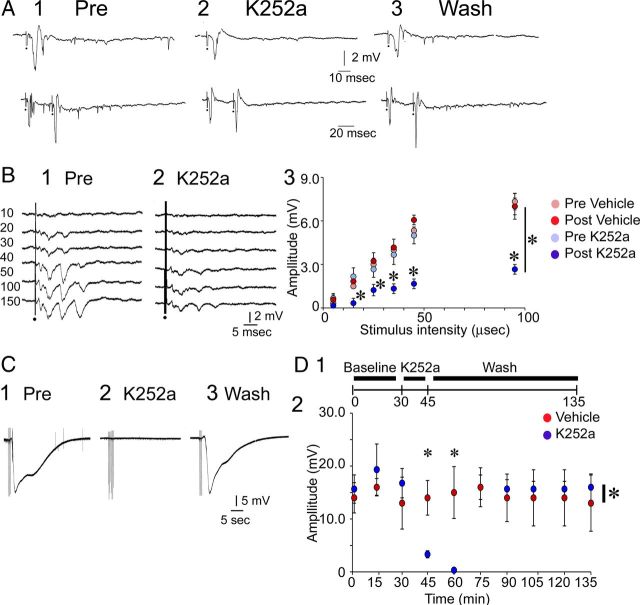Figure 7.
K252a reduces excitability in slices from Gdx rats. A1, The response to MF stimulation is shown before 300 nm K252a was added to the ACSF. Same slices as Figure 6A. A2, The response to the same stimulus is shown 45 min later. The population spikes evoked by the stimulus, especially the secondary population spikes, were reduced by K252a. Spontaneous activity was also reduced. A3, There was a partial reversal after K252a-containing ACSF was replaced by drug-free buffer for 60 min. B1, B2, K252a was perfused onto a different slice from a Gdx rat where rhythmic, repetitive field potentials were evoked (same slice as Fig. 6D). Several stimulus strengths (10–150 μs) were used before (1, Pre) and after K252a application (10–150 μs; 2, K252a). K252a reduced the amplitude of evoked responses. B3, The amplitude of the first fEPSP recorded in stratum lucidum is shown for all stimulus intensities. In addition, data from slices treated with vehicle are shown. There was a significant effect of K252a (comparison of pre-K252a and 30 min after K252a (light blue and dark blue circles): *p < 0.05 (two-way RM-ANOVA followed by post hoc tests), but there were no effects of vehicle (comparison of pre-DMSO and 30 min after DMSO; light red and dark red circles; p > 0.05; two-way RM-ANOVA). C, K252a blocked SD episodes reversibly. C1, An example of an SD episode in response to repetitive MF stimulation (2 half-maximal stimuli 40 ms apart at 1 Hz for 10 s) is shown before adding 300 nm K252a to the buffer. C2, After K252a, the same stimulation did not evoke SD. C3, Sixty minutes after drug-free buffer was resumed, stimulation evoked SD. D1, A timeline of the experiments is shown. MF stimulation (the same stimulus train as in C1–C3) was triggered at 15 min intervals during a baseline, followed by exposure to 300 nm K252a (or vehicle) for 15 min, and drug-free ACSF at the end. D2, A comparison of the effects of vehicle and K252a on the amplitude of SD episodes evoked by repetitive 1 Hz MF stimulation in slices from Gdx rats (n = 3 slices, 3 rats/treatment). Two-way RM-ANOVA showed that there was a significant effect of K252a compared with vehicle: *p < 0.05 (asterisk by the vertical bar; one-way RM-ANOVA followed by post hoc tests) and a significant effect of K252a 15 and 30 min after the start of K252a application: *p < 0.05 (asterisks above symbols).

